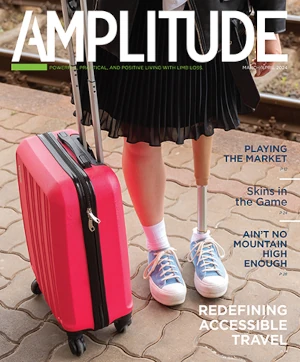
The shoulder-level robotic prosthesis is controlled by a sensor that is placed on the patient’s pectoral muscle. Photograph courtesy of Imperial College of London.
A team of scientists have developed sensor technology that detects signals from nerves in the spinal cord and extracts them to allow a user to control a robotic prosthetic arm by thinking about completing movements, such as pinching two fingers together. The sensor technology interprets the electrical signals sent from spinal motor neurons and uses them as commands. The study was published February 6 in Nature Biomedical Engineering.
A motor neuron is a nerve cell that is located in the spinal cord. Its fibers project outside the spinal cord to directly control muscles in the body. The researchers said detecting signals from spinal motor neurons in parts of the body undamaged by amputation-via targeted muscle reinnervation (TMR)-instead of remnant muscle fiber, means that more signals can be detected by the sensors connected to the prosthesis, compared with conventional, direct EMG control applied after TMR. This, in turn, means more commands could be programmed into the robotic prosthesis, making it more functional.
Dario Farina, MScEE, PhD, who is now based at Imperial College London, England, carried out much of the research while at the University Medical Centre Gottingen, Germany. The research was conducted in conjunction with his co-authors in Europe, Canada, and the United States.
“Moving the focus from muscles to the nervous system…means that our technology can detect and decode signals more clearly, opening up the possibility of robotic prosthetics that could be far more intuitive and useful for patients,” Farina said.
The researchers carried out lab-based experiments with six volunteers who had amputations at the shoulder or transhumeral level. To take part in the study, volunteers underwent TMR at the Medical University of Vienna, Austria. For those with shoulder-level amputations, the nerves were rerouted to the pectoral muscle, and for those with transhumeral amputations, the nerves were rerouted to the bicep. This enabled the team to clearly detect the electrical signals sent from the spinal motor neurons.
To create the technology, the researchers decoded and mapped some of the information in electrical signals sent from the rerouted nerve cells and interpreted them in computer models. These models were compared to models of healthy patients, which helped the researchers to corroborate the results. The team then encoded specific motor neuron signals as commands into the prosthetic design and connected a sensor patch on the muscle that had been operated on as part the rerouting procedure, which was connected to the prosthesis.
The subjects worked with physical therapists so they could learn how to control the device by thinking about specific phantom arm and hand commands. The volunteers were able to move the elbow joint, move the wrist from side to side, and open and close the hand. Ultimately, the scientists want to decode the meaning behind all signals sent from these motor neurons so they can program a prosthesis with a full range of arm and hand functions, which could provide the user with intuitive prosthetic control.
This research has taken the team to the end of the proof-of-concept stage with laboratory tests. The next step will involve extensive clinical trials with a much wider cross section of volunteers so that the technology can be made more robust.
Editor’s note: This story was adapted from materials provided by Imperial College of London.



